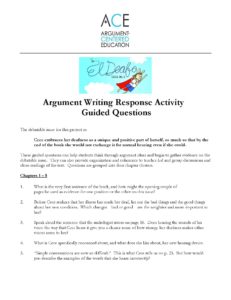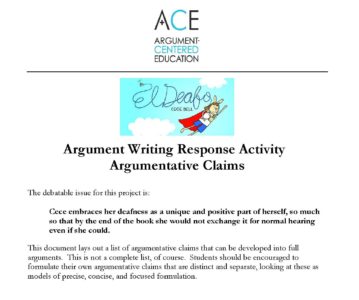
‘El Deafo’ and the Argument Writing Response Activity
El Deafo (2012) is the popular and subtly powerful autobiographical graphic novel by Cece Bell. It tells the author’s story of growing through the middle grades circa 1980, having just been struck mostly deaf by meningitis. The protagonist is shown grappling with how disorienting is her disability at first, then with its social and emotional impact on her early adolescence. The work is notable for its honesty, charm, and surprising poignance.
With one of our partner middle schools this year Argument Centered Education developed the Argument Writing Response Activity (AWRA). Teachers at this school wanted to be sure that the year ended with an argument writing project that brought together some of the skills-building work they had been doing in classroom speaking and discussion, especially in the second semester. AWRA has students make interpretive arguments, respond to other students’ arguments with counter-arguments, and respond to the counter-arguments of their peers. AWRA in effect takes portions of a spoken debate and asks students to put their point/counter-point in written form, enabling students to recognize and enact the underlying bond between classroom argumentative discussion and debate, and academic writing.
This particular unit was condensed somewhat into three weeks at the end of the school year, though it might have been a little more comfortable in four weeks. Because we were working within the calendar’s constraints, however, we put together this implementation plan:
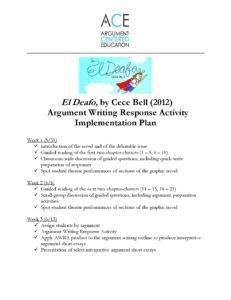 The full activity is laid out in downloadable form in this project overview —
The full activity is laid out in downloadable form in this project overview —
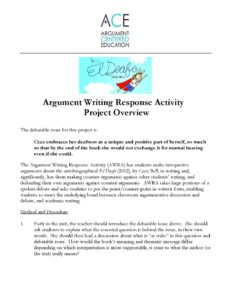 — though we’ll describe the key instructional steps for the Argument Writing Response Activity here in this post.
— though we’ll describe the key instructional steps for the Argument Writing Response Activity here in this post.
Debatable Issue
Early in every argument-centered instructional unit, the teacher should introduce the debatable issue, which for this project on El Deafo is:
Cece embraces her deafness as a unique and positive part of herself, so much so that by the end of the book she would not exchange it for normal hearing even if she could.
The teacher should ask students to explain what the core thematic question is behind the issue, in their own words (something like, Can a person’s disability to so fully accepted and embraced that it becomes a part of themselves that they would not give up for a “normal” ability, even if they could? Is this what disabled people should strive for?). She should then lead a discussion about what is “at stake” in this question and debatable issue. How would the book’s meaning and thematic message differ depending on which interpretation is more supportable, is truer to what the author (or the text) really means?
Guiding Questions
The teacher should organize reading, close reading, classroom-wide discussion, group discussion, and other literacy activities in the unit around the debatable issue, where possible. The El Deafo guided questions (on a separate document) are designed to help do that.
Assign Positions
When reading and discussion activities have reached about the half-way point of the novel, the class should be divided into two halves. One half should be assigned the affirmative position on the debatable issue and one should be assigned the negative position. Students should be encouraged to begin thinking about arguments that can support their position on the issue, based on their reading and the discussion that’s already taken place and that’s to come.
Argument Writing Response Form
After reading and guided discussion of the remainder of the graphic novel has taken place, the teacher should distribute the Argument Writing Response Form, one per student. Students should put their name and class period number on the form, and leave the rest of it blank.
Pairing Students
Students should then be paired: each student should be matched with a pair-partner from the other side of the debatable issue.
Prepared Argumentative Claims
Optionally, the teacher can distribute the set of prepared argumentative claims for this debatable issue.
Some teachers will have incorporated these claims in their instruction and discussion of the chapter clusters already, so they won’t need to distribute the form separately at this point in the project. The teacher also has the option of using one of the prepared argumentative claims from each position to model at this point the construction of a full argument, with evidence and reasoning, as well as a counter-argument to each of these arguments, and refutation of the counter-arguments. If students are still relatively unsure what of the expectations attending each of these argumentation components, modeling at this point is strongly recommended.
Sample claims include:
Affirmative: Cece wouldn’t exchange her deafness for normal hearing
Cece defines her deafness not as a disability but rather as a “special ability,” similar to what superheroes have.
The novel ends happily, with Cece going on a date with the boy she likes and becoming popular with classmates.
Negative: Cece would still exchange her deafness for normal hearing
After she becomes deaf, Cece is repeatedly isolated and marginalized from the “mainstream” of her peers.
Cece’s failed friendship with Ginny proves that deafness harms her personal relationships.
Completing the Argument Writing Response Form
Students should be given 40 minutes to build their two arguments on the AWRA Form. The teacher can circulate to monitor student progress, answer questions, and offer suggestions.
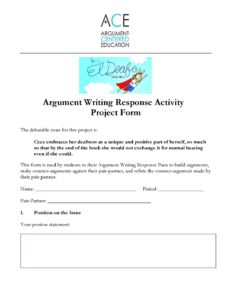 Students should then give their AWRA Form with their two arguments to their pair-partners. Their pair-partner should write their name on the student’s form on the first page (next to “pair-partner”), and they should then read the two arguments and create 1 – 2 counter-arguments to each argument on the form. Counter-arguments can consist either of a critique of flaws in the evidence and reasoning of the argument – identification of a misalignment between the evidence and the claim, insufficiency of evidence, or reasoning that wrongly interprets the text – or of a new argument that contradicts the argument being countered. Typically the latter type of counter-argument is called an “independent counter-argument,” and it should include backing of its own (evidence and/or reasoning).
Students should then give their AWRA Form with their two arguments to their pair-partners. Their pair-partner should write their name on the student’s form on the first page (next to “pair-partner”), and they should then read the two arguments and create 1 – 2 counter-arguments to each argument on the form. Counter-arguments can consist either of a critique of flaws in the evidence and reasoning of the argument – identification of a misalignment between the evidence and the claim, insufficiency of evidence, or reasoning that wrongly interprets the text – or of a new argument that contradicts the argument being countered. Typically the latter type of counter-argument is called an “independent counter-argument,” and it should include backing of its own (evidence and/or reasoning).
When the period for counter-argument creation is over, pair-partners should return the AWRA Form to the original student, who should then refute the counter-arguments written into the form by their pair-partner. Refutation should not merely be a statement of the argument. That isn’t really refutation, it’s repetition. Rather, refutation should address the substance of the counter-argument, and through analytic thinking and reference to evidence explain why the original argument is stronger and still stands.
Completion, Collection, and Assessment
The teacher should collect the Argument Writing Response Forms from each student. It is recommended that they are assessed using an ACE assessment rubric and form with three components: argumentative claims, evidence/reasoning, and refutation.
Cross-Applicability
The Argument Writing Response Activity is cross-applicable to virtually any literacy unit. It is an argument-based strategy that foregrounds written argument, critique, and refutation. It can be scaffolded up or down by, for instance, supplying an evidence set from the text(s) or limiting (or eliminating) the use of prepared argumentative claims. And it organizes instructional content around the focus provided by the unit’s debatable issue. So it’s resource with high rigor, standards orientation, durability, and adaptability.


